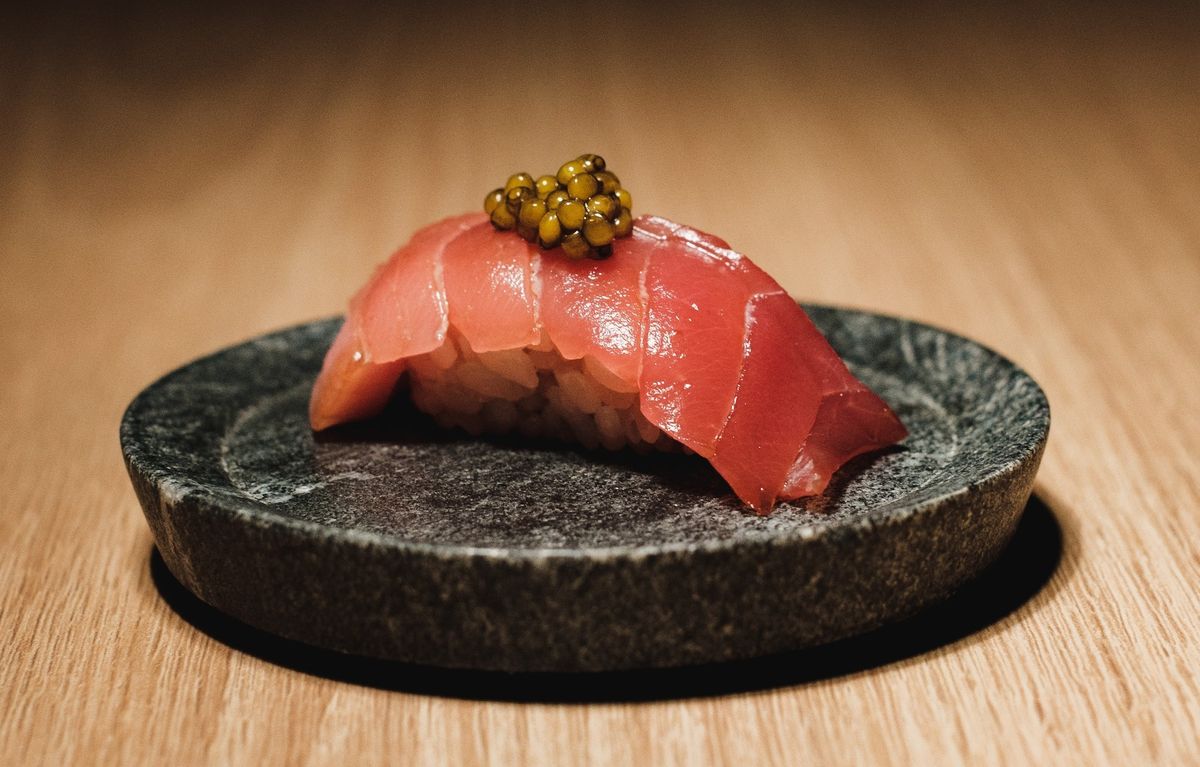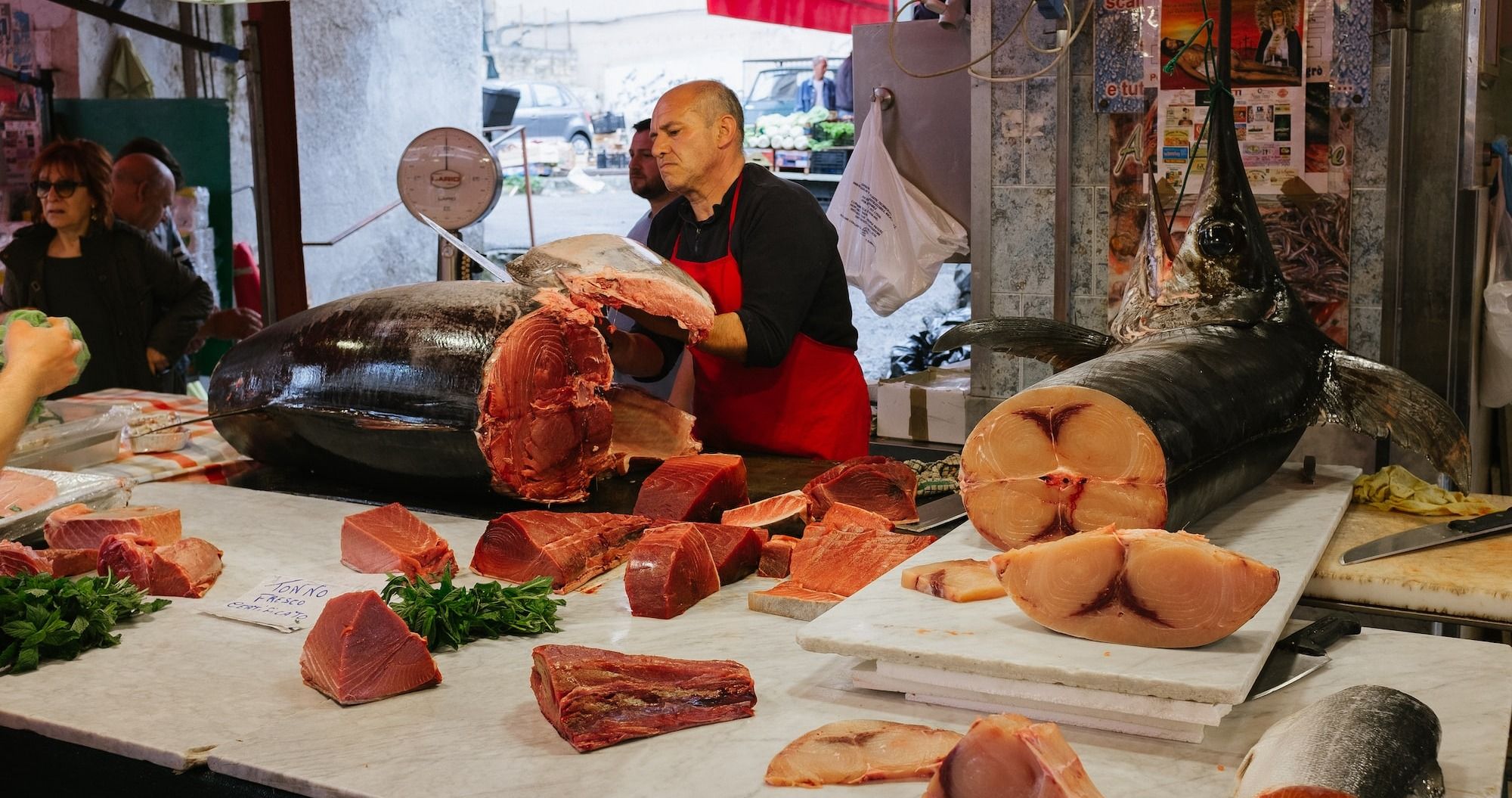Tuna Gourmet Guide: Slice, Preparation and Taste Explained
Dive into the enigmatic world of Bluefin tuna—a culinary gem of the ocean—as we demystify its allure, guide you through the art of slicing and preparation, and help you savor it like a true gourmet.

Tuna or Maguro belonging to the Scombridae family, predominantly thrives in the Pacific Ocean, although smaller numbers are also found in the Atlantic, Indian Ocean, and even the Mediterranean and Black Seas.
These fish prefer the warm, upper layers of open water, with Skipjack Tuna notably favoring temperatures of 78 degrees Fahrenheit or above.
Once overshadowed by sardines, tuna gained culinary prominence in the early 20th century for its delicate white flesh and delightful flavor when steamed.
Commercial canning of tuna kicked off in the United States in 1903, and its demand surged during World War I as it became an essential part of the American soldiers' diet.
Fast-forward to the 21st century: innovations like vacuum-sealed pouches and diverse marinated flavors have only bolstered tuna's status as a versatile and beloved seafood staple, whether enjoyed as an affordable convenience or as part of gourmet cuisine.
But what makes the mighty tuna—especially the Bluefin variety—stand out among other fish? How does one slice it, prepare it, and savor it like a gourmet? Allow us to unravel the mystery that surrounds this delectable creature of the sea.
The Tuna: A Culinary Jewel from the Ocean
Firstly, the prized Bluefin tuna, scientifically known as Thunnus thynnus, has an exceptionally high fat content, giving it a marbled, buttery texture and a unique, savory flavor profile.
This fish can fetch exorbitant prices, often reaching up to $3,000 per pound in high-stakes auctions, making it one of the most expensive ingredients on the planet.
You might question why Bluefin tuna commands such a luxurious price point.
It's not solely about scarcity, but also the unmatched gastronomic journey it provides, often showcased in the esteemed settings of Omakase and Kaiseki dinners or upscale restaurants.
For the health of our oceans and the declining Bluefin tuna population, choose sustainably caught options when indulging in this culinary luxury.

Selecting Premium Maguro
Securing a top-quality maguro (tuna) can be hit-or-miss if you're not equipped with the right know-how. Here's how you can effortlessly pick out the freshest and most flavorful maguro.
Muscle Fibers Tell a Story
Examine the muscle arrangement closely; you're looking for parallel or diagonal fibers. Fewer, slenderer tendons are a hallmark of superior maguro. Excessive or intricate tendon patterns often signify a less appealing, stringy texture.
Color is Key
Quality maguro will sport a vibrant red hue or a delicate pale pink if it's bincho-maguro. A fading color or a shift to brown or white often indicates the fish is past its prime.
Spotting the Spots
Beware of red or black dots on the surface, as these are telltale signs of subpar quality. These spots often appear due to incomplete blood removal and usually come with an off-putting odor.
Say No to Drip
Avoid maguro that's sitting in a pool of liquid. This leakage suggests that the fish has been thawed for an extended period, leading to a loss of its savory essence, or umami.

The Art of Slicing: The Hōchō Mastery
By delving into the intricacies of Hōchō, the revered Japanese craft of fish slicing, you elevate your tuna experience to a whole new level.
This isn't your everyday chopping; Hōchō is a precise art form that safeguards the fish's cellular integrity, thereby maintaining its unparalleled flavor and tenderness.
When you understand and apply Hōchō, you're not just slicing tuna—you're honoring it.
Choice of Knives
The tools of this craft are specialized Japanese knives, with Yanagiba and Deba being the most prominent.
Yanagiba is a long, slender knife ideal for slicing sashimi, while Deba is a thicker, sturdier knife used for more substantial cuts and filleting.
These knives are engineered to glide through the flesh in one fluid stroke, minimizing cellular damage.
The Art of Saku Blocks
When it comes to creating 'Saku' blocks—square or rectangular cuts of tuna—cutting against the grain is paramount.
This counter-grain technique ensures that the meat retains its soft, melt-in-your-mouth texture, which is a hallmark of high-quality sashimi and sushi.
Perfecting Sashimi Slices
For sashimi, precision is key. Each slice should range between 1/4 to 1/8-inch in thickness. Achieving this perfect thickness allows for an optimal balance between texture and flavor, letting you experience the full essence of the tuna.
In essence, Hōchō is more than just slicing; it's a form of culinary sculpture. When done right, each cut is an artwork that enhances both the visual and gastronomic experience of the tuna.

A Canvas of Preparation Techniques
Bluefin tuna is a culinary chameleon, perfectly suited to a wide array of preparation techniques, each with its own distinct taste profile.
Sashimi: Oceanic Purity in Akami
Bluefin akami sashimi delivers an unfiltered essence of the sea, commonly accented with a mere brush of soy sauce or a touch of freshly grated wasabi.
The palate is graced with a clean, subtly sweet richness that is the hallmark of tuna's natural flavors.
Grilled Tuna Steaks: The Smoky Elegance of Toro
Grilled toro steaks transform the fish, revealing a smoky, robust, and multi-layered profile.
Many gourmands prefer the steak to be seared on the outside but left raw inside, achieving a dichotomy of textures while retaining the tuna's authentic, oceanic sweetness.
Tuna Tartare: The Flavorful Palette of Otoro
Tuna tartare, especially when made with otoro, achieves a culinary complexity through a harmonious mix of capers, shallots, and a drizzle of high-caliber olive oil.
This brings out the natural umami of the otoro, creating a nuanced yet powerful flavor symphony where its creamy, mild sweetness coexists perfectly with savory and aromatic elements.
In summation, Bluefin tuna—be it akami, toro, or otoro—stands as a culinary wonder, each cut offering a unique and transformative gastronomic experience.
The Essence of Pairing: Wine and Tuna
Consider pairing your tuna dish with a rich Chardonnay or a crisp Sauvignon Blanc. The wines not only complement the dish but elevate the dining experience, making each bite an ethereal journey.
Maguro: A Health Gem from the Sea
Tuna is a nutritional dynamo, offering a lean, protein-rich profile with minimal fat. It's loaded with Omega-3 fatty acids, which are essential for heart health and may also mitigate conditions like depression and inflammation.
Rich in Vitamin D and Selenium, tuna boosts bone health and strengthens the immune system.
Both fresh and canned varieties make an excellent addition to a balanced diet. Health experts recommend 8-12 ounces of seafood like tuna per week for optimal wellness benefits.
Uncommon Facts: Did You Know?
- Perpetual Motion Machines: Tuna need to maintain a constant speed, covering their own body length every second, just to ensure they get enough oxygen for survival.
- Speed Demons: These oceanic sprinters can hit speeds of up to 43 mph, making them one of the fastest fish in the sea.
- Voracious Eaters: To fuel their constant activity, Tuna can consume up to 10% of their body weight in food each day.
- Thermal Oddities: Unlike their cold-blooded aquatic peers, Tuna maintain a body temperature slightly above their watery surroundings.
- Market Dominance: Tuna accounts for more than one-third of all fish and seafood sales in the United States.
- America's Second Love: Following shrimp, canned Tuna enjoys the silver podium as the second most popular seafood product in the U.S.
Conclusion
The moment you take that initial bite of expertly crafted tuna, you're not merely indulging in a meal—you're partaking in an oceanic symphony that tantalizes your taste buds and leaves an indelible mark on your culinary soul.
So, when the occasion to relish tuna arises, keep in mind that this isn't just sustenance; it's a celebration, an homage to one of the sea's most remarkable gifts.
In essence, Bluefin tuna is a multifaceted culinary masterpiece, with each preparation offering its own distinct gastronomic journey.
Bon Appétit!


